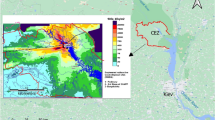Abstract
Natural analog studies provide a means to test assumptions in performance assessment models. Data on the spatial distribution of metals derived from archeological artifacts at Akrotiri, Greece, were used to evaluate performance assessment model assumptions of radionuclide transport through unsaturated volcanic tuffs hosting the proposed repository at Yucca Mountain, Nevada. Processes controlling transport of trace elements from 3600 year old metallic artifacts at Akrotiri are analogous to processes controlling radionuclide transport at Yucca Mountain. Archeological information temporally and spatially constrains the source and chemistry of these trace elements, providing a comparison basis for model validation efforts. Despite these constraints and characterization of the Akrotiri site, the data are open to different interpretations as the extent of the plume emanating from the Minoan artifacts, transport pathways, heterogeneities in parameters, and boundary conditions are uncertain. Rather than validating a conceptual model of flow and transport, the Akrotiri site data indicate that 1-D models of aqueous phase transport in the unsaturated zone are conservative. Different conceptual models, apparently matching site data, produce different predictions illustrating that predictive flow and transport modeling is uncertain due to under-determined parameters and boundary conditions.
Similar content being viewed by others
References
W.M. Murphy and E.C. Pearcy in Scientific Basis for Nuclear Waste Management XIX, edited by W.M. Murphy and D.A. Knecht Mater. Res. Soc. Proc. 412, Pittsburgh, PA, 1996) pp. 817–822.
W.M. Murphy, E.C. Pearcy, R.T. Green, J.D. Prikryl, S. Mohanty, B.W. Leslie, A. Nedungadi, J. Cont. Hydr. 29, 245 (1998).
W.R. Hamon, Int. Assoc. Sci. Hydrol. Publ. 63, 52 (1963).
P.W. Schindler, P. Liechti, J.C. Westall, Neth. J. Agric. Sci. 35, 219 (1987).
W. Salomons and U. Föstner, Metals in the Hydrocycle (Springer, New York, 1984).
N. Oreskes, K. Shrader-Frechette, K. Belitz, Science 263, 641 (1994).
Author information
Authors and Affiliations
Corresponding author
Rights and permissions
About this article
Cite this article
Hughson, D.L., Browning, L., Murphy, W.M. et al. An Archeological Site at Akrotiri, Greece, as a Natural Analog for Radionuclide Transport: Implications for Validity of Performance Assessments. MRS Online Proceedings Library 608, 557 (1999). https://doi.org/10.1557/PROC-608-557
Published:
DOI: https://doi.org/10.1557/PROC-608-557




